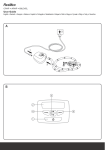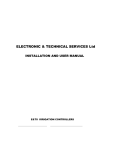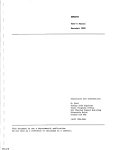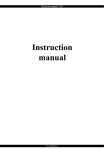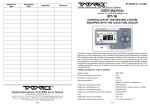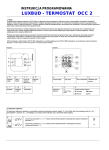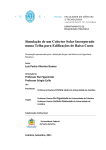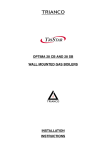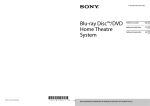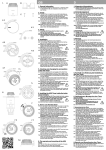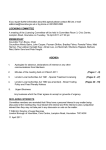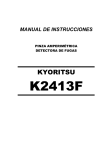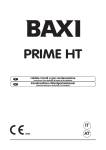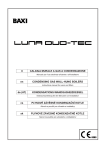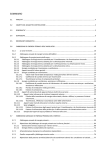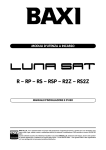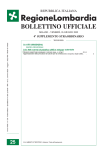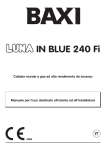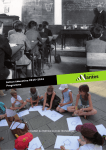Download therm cascade boiler rooms
Transcript
THERM CASCADE BOILER ROOMS CASCADE CONTROL SYSTEM FOR THERM TRIO 90(T), DUO 50(T), (FT), 20 and 28 (LX, LXZ, TLX, TLXZ), 14 (X, XZ, KX, TX, TXZ, TKX) BOILERS (with DIMS01 –TH01 automatics) THERM CASCADE BOILER ROOMS 3/2006 THERM CASCADE BOILER ROOMS 1. WHAT IS A CASCADE SYSTEM A cascade is a connected system of more Therm boilers. Its unique way of connection and the construction of Therm boilers allow continuous increase of the installed output starting at 35% of nominal capacity of the smallest boiler. If more capacity is required (up to 1MW) the cascade system has many advantages. Especially, using Therm DUO 50(T) or TRIO 90 is highly advantageous because of the relatively little used space and the high installed output, with all the advantages of a cascade and its continuous output modulation maintained. However, not only DUO or TRIO boilers can be used in a cascade. THERM DUO 50(T) and THERM TRIO 90 can be combined with other THERM boilers and in this way, the system can be adapted to the calculated heat loss of the building and to the DHW need. In the field of heating system technology, the cascade system is a pioneering method of optimizing installations with high output. Instead of one boiler with high capacity which would have to work as a whole even when only little output is demanded, in the cascade system as many boilers as you need at the moment will work. The number of boilers to work is controlled electronically. Experience proves that 80% of time in the heating season the boiler capacity is used at only 50%. During the entire season the boiler is used at only 30%. It means bad use and inefficient operation. As obvious, a cascade system provides the immediate needed capacity by connecting more “small” boilers as opposed to one big boiler with inefficient operation at small outputs. The cascade programmed control removes the troubles of setting the optimum ration of the system capacity and heat consumption. The wide range of control enables long-time operation with lower heating water temperatures, which reduces the losses caused by emissions and the losses arising when the system is in the emergency mode. This enhances use of the system and makes the conditions in the heated environment more pleasant, in other words, this improves the user’s comfort. The consistent use of information technologies makes a control optimising the boiler room performance in every moment possible. So far, the boiler room operation was controlled by an expensive system of cascade controllers. Using a communication interface, which enables the information transfer among the boilers and also a continuous output modulation of all boilers at the same time, has been a major step. It means not only that the boilers can achieve the most efficient output at any moment of the operation but also that there is an immediate access to current information and possible analysis of any problem which could arise. A today’s cascade boiler room is really intelligent equipment which works independently, without a “fallible” man’s intervention. The solution with a clever use of standard hardware and software at reasonable prices is then accessible for everybody. Cascade boiler rooms are the best response for the acute demand for optimum solution for current problems of middle-sized and small heat and DHW consumers. They are of a great interest to both professionals and investors because of their basic advantages: • exceptionally advantageous investment • uniquely economical operation • fully automated operation • environment-friendly • high operational reliability • simple and easy technical solution • little used space – saves floor space • adapted for possible external DHW tank connection The fact the cascade boiler room does not require any special location means it can be placed almost anywhere. Installing boilers in the loft saves space and removes the need of a high chimney because of bad atmospheric conditions. 3/2006 THERM CASCADE BOILER ROOMS It is possible to use several THERM DUO 50, 50T boiler units (up to 16 units in one cascade system, which means the maximum output of 720 kW) or THERM TRIO 90 (up to 10 units in one cascade system, which means the maximum output of 1 MW). A tailor-made cascade system then provides an optimum heat source and it is the required compromise between an individual and central (external) heat delivery for flats and facilities. To sum up, the cascade boiler rooms can be set up quickly using pre-prepared modules, they can be reconstructed while the boiler room is fully operational, they are easy to service and maintain and they have long life; last but not least, their surrounding remains untouched with no non-aesthetic external distribution nets. Moreover, THERM boiler cascade can be located at almost any place. Since the start of the THERM boilers development and their cascading in 1993, it has been attracting attention of experts both in the Czech Republic and abroad. Cascade boiler rooms have been awarded many prestigious professional prizes, mainly because of their flexible innovations and immediate use in the practice. Nowadays, they are the unrivalled technological top in their category, thanks to the perfect programming and unlimited communication possibilities. If you are interested, you can get the best idea of the cascade boiler room economy at www.thermona.cz where some examples of the real installations including the assessment of their costs and return on investment are provided. 2. DESIGNING A CASCADE SYSTEM When designing a cascade, it is necessary to consider the following points: 2.1 Calculate the heat need from the point of view of heat transmission of the installed heating system, which has to correspond to the cascade capacity. The number of boilers is to be determined in relation to this capacity. 2.2 Choose the location of heat sources. 2.3 Design the composition and the dimensions of the individual hydraulic parts of the cascade system according to the cascade capacity. 2.4 Determine the bulk flow from the system capacity and determine the output of the main circulation pump behind the hydraulic equalizer of dynamic pressures. 2.5 Design the flue exhaust, or a common collector. 2.6 The control, the operations and the setting of the cascade. 2.1 Calculating the number of boilers The basic data for designing a boiler room, for choosing the wiring diagram and for dimensioning all the equipment is the installed capacity of boilers, which is called the connecting heat output of the heat source. That is the heat output necessary to cover the heat losses of the building and the heat needs of other appliances (DHW heating, airing, etc.). The boiler room capacity is not just the sum of all maximum power requirements because the heat consumption changes with time; it has to be determined individually. Norm ČSN 06 0310 provides the calculation for these kinds of operation. 3/2006 THERM CASCADE BOILER ROOMS 1. Heating a facility with interrupted airing and DHW heating. QPRIP = 0.7 x QTOP + 0.7 x QAIR + QDHW (W, kW) 2. Heating a facility with permanent airing or permanent technological heating. QPRIP = QTOP + QVT (W, kW) 3. Heating a facility and DHW heating with a through-flow system with preferential DHW. QPRIP = the higher value out of the need for heating or DHW heating. where: QPRIP – installed boilers capacity (total boiler room capacity) (W, kW) QTOP – facility heat loss with local external calculated temperature (W, kW) QAIR – heat input of air-conditioning technology (forced airing) (W, kW) QDHW – heat input of DHW heating (W, kW) QVT – heat input for airing or technological heating It is recommendable to give the design of boiler room capacity great attention. The calculation of the heat consumption and the heat loss is often underestimated and the result is a boiler room with over-dimensioned boilers or with insufficient capacity. This leads to inefficient and uneconomical operation and useless increase of investment costs or the heat source is considered insufficient by the user. It is especially necessary to proceed carefully and properly when reconstruction solid fuel boiler rooms, where the installed output of the current boilers is in almost every case over-dimensioned, sometimes by more than 100%. 2.2 Choosing the location of heat sources It is necessary to use the diagram of the heating system to consider if a central heating system or a system of more decentralized groups of boilers with calculated outputs is more convenient. The decentralization can be more suitable because of easier control and lowering of hydraulic and heat losses in the system. Also, it is necessary to decide what kind of flue exhaust will be more convenient – a common chimney or an exhaust of every individual boiler etc. Moreover, the kind of airing needs to be considered and adapted to the kind of boilers. 2.3 Designing the individual hydraulic parts of the cascade system Several basic technical regulations need to be observed when designing and installing a cascade system. If these are met, you will avoid some basic mistakes that could later influence the use of the system. Especially, these points need to be given attention: - non-return flap valve, filter, draining and closing valve under each boiler - hydraulic distributor + hydraulic equalizer of dynamic pressures (HEDP) - safety device - DHW heating solution - the main circulation pump in the secondary circuit (see the following chapter) 3/2006 THERM CASCADE BOILER ROOMS Non-return flap valve There must be a non-return flap valve under each boiler in the cascade. The valve when the excess pressure is about 20 mbar. It is installed to prevent heat losses that could be caused by the emission of heat over the heat exchangers that are not operational at the moment. Filter It is strongly advisable to use filters in the system. There is a lot of dirt, impurities, rust and stone, especially in the older heating systems. Filters prevent the dirt from getting to boilers and their damage. Filters need to be place in the non-return valve of every boiler. Besides these filters that are located under each boiler, there can be a system filter. This one is located in the return branch of the primary circuit in front of the hydraulic equalizer of dynamic pressures. Draining valve We recommend placing a draining valve under each boiler in the cascade. This will be especially convenient for service technicians in cases of emergency or even a regular check. Draining valves are related to closing valves. Closing valves Installing closing valves is a very good investment. These valves are located on the inlet and outlet of the heating water from the boiler and they allow the user to close the inlet of heating water to the boiler, which then can be easily drained using the draining valve. These valves can be used only when the boiler is disconnected and unoperational, e.g. because of maintenance work! The valves should never be used when the boiler is running! Hydraulic distributor + hydraulic equalizer of dynamic pressures (HEDP) If the cascade system is to work properly, it is necessary to separate the boiler circuit and the heating circuit because the bulk flow of boiler circuit water is variable dependent on the number of working boilers. The bulk flow of the water in the heating circuit also changes when mixing valves are used to regulate independent heating zones. To separate the boiler circuit and the heating circuit, a hydraulic equalizer of dynamic pressured HEDP (torus) is used. We recommend using a typified hydraulic distributor with an integrated torus Thermset for specific connection of hydraulic parts of Therm boiler cascade. The producer provides a wide range of distributors that can be chosen in relation to the number and the kind of connected boilers and the dimensions of the boiler rooms. Thermset hydraulic distributors are produced as a left version (HEDP on the left) and as a right version (HEDP on the right). These versions are further divided into Thermset LINE and Thermset BACK. Thermset LINE serves for easy connection of boilers located in a line. Thermset BACK is used to connect boilers standing in two lines with their back to each other. This system is used in cascades installed for example in the centre of a boiler room, where boilers are suspended on a common support frame. 3/2006 THERM CASCADE BOILER ROOMS A diagram of equalizer of dynamic pressures including the approximate recommended ratio dimensions: deaerating valve - heating system sensor - circulation pump draining valve Examples of signs of Thermset hydraulic distributor types: DUO THERMSET BACK 180 / 4 Number of boilers in a cascade (4 units) Total cascade capacity (180 kW) Layout of boilers (Back - two lines with backs to each other) Type of boilers in the cascade (Therm DUO 50) TRIO THERMSET LINE L 360 / 4 Number of boilers in a cascade (4 units) Total cascade capacity (360 kW) Torus location (onthe left) Layout of boilers (Line - in one line) Type of boilers in the cascade (Therm TRIO 90) 3/2006 THERM CASCADE BOILER ROOMS EXAMPLES OF THERMSET HYDRAULIC DISTRIBUTOR VERSIONS 3/2006 THERM CASCADE BOILER ROOMS Safety system of the boiler room The system of the heat source (a boiler room and the heating system) is directed by valid regulations (ČSN 06 0830). Its current version makes designers quite free as far as the safety precautions are concerned. The total volume of water in the heating system changes with its temperature. Water cannot be compressed and when heated up its volume increases. The extra volume needs extra space. For these reasons, expansion vessels are used to “store” the extra volume and a safety device prevents the system from exceeding the allowed pressure. To calculate the expansion vessel volume, the dimension of the safety pipings and to design the safety valve use the calculations included in valid regulations (ČSN 06 0830). The volume of the expansion vessel depends on the volume of heating media in the heating system! When designing a new system of central heating, it is easy to calculate the water volume. The volume is then the sum of the volume of water in boilers, in pipings, in heating radiators and in other parts. The data on the water volume in individual parts are provided in project documents of their producers and the water volume in the piping can be calculated out of the tables of piping dimensions. Some producers of expansions vessels provide a simple application to calculate the heating media volume in the system; such an application can usually be downloaded free from their websites. The trouble is if we need to find out the water volume in a current (old) heating system, which is virtually impossible given the lack of documents. When determining the water volume in current system, the experience and comparison with new systems are used. The volume is then recalculated to 1 kW of installed heating radiators (not the heat losses or boiler output!): Systems with plate radiators.......................... 9 - 12 litres Systems with sectional radiators...................14 - 16 litres Systems with convectors................................ 7 - 9 litres The lower value is applicable to smaller systems or to systems with forced heating water circulation and the higher value is applicable to larger systems or to systems with gravity circulation. Be aware, this is only an estimate, and it is necessary to proceed carefully and to consider all possible influences. Further, it is necessary to add the volume of the water in boilers! If in doubt, it is better to consider higher volumes. Under-dimensioned expansion vessel would cause considerable troubles with operational pressure fluctuation (which can cause an accident), an over-dimensioned expansion vessel is “only” more expensive, but the heating system can then work without troubles. DHW heating As the introduction chapter has shown, the Therm cascade can also provide a reliable and efficient solution for DHW heating. Heating DHW is in some ways specific, which is necessary to observe. The basic rules to calculate the DHW heating equipment are stated in valid regulations (ČSN 06 0320). 3/2006 THERM CASCADE BOILER ROOMS Other specific points: - the boiler is connected to the tank via a three-way valve (see the photo) - the time the three-way valve needs to reset itself must be maximum 8 seconds - the connection needs to be as close under the boiler as possible - the output of the boiler connected to the DHW tank should correspond with the output of the heater or heat exchanging surface in the tank. If the boiler is overdimensioned in relation to the heater, the heating water in this circuit is overheated and the boiler starts cycling. - DHW heating can be provided by all controlled boilers. Only the controlling boilers cannot heat up a tank. Example: A cascade consists of 5 DUO 50 boilers. One boiler is the controlling one – superior to the others. The other four boilers are controlled. It means all the four boilers can be connected to a DHW tank over a three-way valve. Terms such as a controlling boiler, a controlled boiler etc. are defined in the chapter Control. - the three-way valve needs to be connected in the following way (see fig.): - DHW heating is always dominant over the heating system; it means if the DHW temperature falls, the boiler resets the valve from the heating system to the tank heater and starts heating DHW. 3/2006 THERM CASCADE BOILER ROOMS Time of heating water in Therm tanks The following table was created out of empirical measuring of time needed to heat up a tank when the tank was filled with cold water (10°C) and then heated up to the temperature set be the tank thermostat (60°C). Times are indicated in minutes. Tank type DHW DHW Heater volume heated by capacity [l] °C [kW] OKC 40 NTR Therm 40 Therm 55 stainless Therm 60 Therm 100 OKC 125 NTR OKC 160 NTR OKC 200 NTR OKC 200 NTRR OKC 300 NTRR OKC 400 NTRR OKC 500 NTRR OKC 750 NTRR OKC 1000 NTRR 14 Boiler capacity [kW] 20 28 45 90 the time of tank heat-up in minutes 6 6 unsuitable unsuitable 38 36 50 50 14 22.4 10 9 55 50 25 13 9 7 58 95 120 160 210 200 292 380 470 731 958 50 50 50 50 50 50 50 50 50 50 50 17 24 24 24 24 48 72 82 98 93 100 13 25 29 38 38 48 70 91 113 175 229 9 17 20 27 27 34 49 64 79 123 161 unsuitable 14 17 22 22 24 35 46 56 88 115 unsuitable unsuitable unsuitable unsuitable unsuitable unsuitable unsuitable 14 22 28 35 54 71 unsuitable unsuitable unsuitable unsuitable unsuitable unsuitable unsuitable 16 18 27 36 For DHW consumption in litres we can use the following values: The type of facility Some specifications Consumption min.-max.: flats work days 100–110 l/person/day weekends 140-160 l/person/day with showers 90-110 l/person/day with a kitchen in the building 120-130 l/person/day hotels including staff 130-200 l/person/day camps, restaurants including staff 80-100 l/person/day lodging houses kitchens schools 10 l/meal including staff 20-30 l/pupil sports facilities with showers 50-70l/person/day roofed swimming pools 60-100 l/customer industrial buildings clean workshops 20-25 l/person/day engineering industry 35-50 l/person/day dirty and dusty workshops 50-60 l/person/day hot and dusty workshops 80-100 l/person/day 3/2006 THERM CASCADE BOILER ROOMS Connecting the tank to cold water inlet The connection must be carried out in compliance with valid regulations (ČSN 06 0830) – for safety precautions of central heating and DHW heating, will all fittings (see fig.) U-closing tap at the cold water inlet Z-testing tap K-return valve P-safety valve M-manometer E-expansion vessel (recommended) Besides these necessary fittings it is possible to fit an expansion vessel to the cold water inlet, which will cover the DHW expansion when the tank is being heated up and will prevent opening the safety valve. However, it is necessary to use an expansion vessel designed for this purpose! Never can be used an expansion vessel for heating systems! (different pressures, different material…) The tanks without a draining hole have to be fitted with T piece with a draining valve at the DHW inlet. Tank exchanger is fitted to the heating water source (e.g. a gas boiler) and the thermostat controls DHW heating. If the three-way valve and the pump are connected suitably, the heating water source heats up the domestic water automatically and the DHW heating is dominant over “space” heating. To reach the demanded DHW temperature set on the thermostat, the heating water temperature must be min. 5°C higher (15°C is recommended). Tanks work on a pressure basis. There is a permanent water pressure in the tank. In this way, DHW can be taken to locations with a higher pressure fall from the tank. If the DHW distribution net is long, we recommend using a circulation system. All connecting nets need to be properly insulated. Cold water is to be connected to the inlet marked with a blue ring or a sign "VSTUP TUV" = “DHW INLET”. The safety valve is to be fitted according to the manual. Hot water is to be connected to the outlet marked with a red ring or a sign "VÝSTUP TUV" = “DHW OUTLET”. The heating circuit is connected to the marked inlets and outlets of the heater exchanger and the deaerating valve is fitted to the topmost spot. Electrical connection of the DHW tank to the boiler Type 14, 20, 28, DUO 50 boiler with a closing voltage of tank thermostat 24V DC are only connected with the tank by a twisted pair (this must be a cable, not a wire!) and they require a tank thermostat with gilded contacts. Boilers marked LO have the closing voltage of tank thermostat 230V/50Hz. With this voltage, it is necessary to use a twin and earth cable with double insulation, to connect by protection green/yellow conductor and to carry out protective interconnection. Boilers marked EZ/B sense the DHW in temperature in the THERM 100/B tank by NTC resistance sensor wound in the rear part of the boiler. The tank must be earthed with proper connection of earth conductor at the fastening bolt. For more information on tank products go to www.thermona.cz. 2.4 Designing the system pump It is quite easy to design the right system pump but it cannot be underestimated. An over-dimensioned pump can cause troubles as well as an under-dimensioned one. The heat input to the central heating system and the heat drop of water determines the needed volume of heating water and the pump needs to provide its circulation. The appropriate pump can be chosen from the catalogues of producers of pumps; this pump’s characteristics should correspond to the required capacity parameters for the 3/2006 THERM CASCADE BOILER ROOMS transported amount. The optimum operational point is selected on the operational curve of the pump; the point determines the pressure the pump can provide for the transported amount. This pressure is then considered when calculating the rest of the central heating system for the hydraulic calculations of the piping. Thus, the operational point of the pump and the operational characteristics of the system are determined. On the basis of the transport output, the weight transported amount mdop (kg/sec) or the volume transported amount mobj (l/sec) of the pump are set. The basic relation of the heat usable from the heating water is expressed as a relation of the weight volume of water, specific heat water capacity (specific heat) and temperature difference (water cooling when heat is transferred): Q = m dop .c.∆t (J) When modified, we can acquire the relation for the calculation of water weight with the set volume of heat we can get from water when cooling it. The water weight can be calculated using this formula: mdop = Q c.∆t (kg) where: Q = transferred heat volume (J) mdop = weight of water (kg) c = water specific heat (J/kg.°K); when the water temperature is medium tm = 80 °C then c = 4230 J/kg.°K ∆t = water cooling – the difference between the inlet and the outlet temperature – after heat transfer (°C) 2.5 Designing flue exhaust The basic guideline for calculating a common chimney is a valid norm (ČSN EN 13384-2). The calculation of the flue exhaust carried out in compliance with the guideline expects a computer application to be used for every boiler room. The issue of flue exhaust is often underestimated when reconstructions are carried out although the norm makes it clear that every flue exhaust must be calculated. The application that is often used to calculate a common chimney is one developed by ProTech, which also includes Therm boilers. Some principles that have to be taken into consideration when designing a chimney: - maximum of four appliances can be connected to one chimney ventilation pipe. If there are more boilers in the cascade, it is necessary to design more chimneys. 3/2006 THERM CASCADE BOILER ROOMS - for the calculation, the temperature conditions of the chimney and its pressure conditions are to be assessed individually. - the chimney must be designed for all extreme conditions, i.e. for summer and winter, for minimum and maximum operation etc. - DUO 50 T boilers cannot be connected to a common flue collector! (type B appliance) If this condition is not met, the flue can escape to the neighbouring boiler over the exhaust interrupter! The flue exhaust of DUO 50 T boilers needs to be carried out independently, using ∅80mm piping. The maximum possible length of the exhaust is then 5m. The boilers used most frequently for cascades are Therm Duo 50(T) and Trio 90 boilers. These appliances are of type B – they have an open combustion chamber. Therefore, it is necessary to consider sufficient airing of the boiler room! 2.6 Control, functions and setting of a cascade Description of controls As the cascade boiler rooms with autonomous control using an interface are extremely popular, we are offering a new generation of this simple control that can use all the qualities of the boilers. The basic criterion was the possible use of highly advantageous qualities of Siemens QAA 73.110 communication controller. This made us develop new interface for the control boiler of the cascade called IU05q (when using the older Chronotherm CX 51 MC the interface is marked IU05), which transmits information not only among the other boilers in the cascade but also with Siemens QAA 73.110. The controller analyses the output temperature of the heating system, therefore, the regulation software was modified and the temperature sensor of the heating system was relocated to the torus outlet. At the same time, the communication among boilers (RS 485) has been expanded by operational and failure information from the control boilers to be indicated in the controller; in the future it will be possible to monitor the cascade operations from a computer. The modified interface for control boilers is marked IU04.10. Several changes have also been done to the boiler processor with a new control panel marked DIMS01-TH01. For the control boiler with IU05 and controlled boilers with IU04.10, software version 1.00 MB and higher is necessary (for TRIO 90 boilers v. 1.03 MB and higher). At the beginning of 2005 the production of Chronotherm CX 51 MC controller was finished and then it was sold out. Currently, we are offering Siemens QAA 73.110 controller, which has similar features and qualities. A detailed manual for this controller can be downloaded from www.thermona.cz. For a very comfortable control of the cascade, there is a regulation system with programmable Tronic 2008E controller. This can provide an independent control of up to 6 regulation circuits and it is able to send orders via communication line and control the entire cascade according to their current needs. At the same time, it is able to collect operational data from technological circuits and from the cascade and present them (e.g. using a common serial interface RS232 or RS485, or a GSM gate or a modem) to a possible remote boiler room control centre. Other features of this controller: remote processing of signals, simple programming, remote comfortable graphic visualisation of parameters and their settings, data archiving and management, variable time programs etc. Examples – versions – of typical project cases that are already available in Thermona include designs of TRONIC 2008E regulation system hw and sw equipment and they can be adapted to the specific needs of the controlled technology, if the user wants more than the standard solution. TRONIC 2008E systems can be programmed on a PC in WINLEDA graphic environment. This comfortable software enables designers and users – not only programmers – to work with control program efficiently and without delays. 3/2006 THERM CASCADE BOILER ROOMS Typical examples of TRONIC 2008E control system for cascade boiler rooms: Version no. 1: 2 heating branches regulated by weather compensation - analogue electric actuators 0-10V DC/24V - safety precautions of the boiler room – safety valve; signalization of flooding, gas leaks, fire; automatic refilling of heating circuit by solenoid valve; control of heating circuit pumps, of DHW circulation Version no. 2: 2 heating branches regulated by weather compensation - three-point electric actuators 230V (e.g. Komextherm) - safety precautions of the boiler room - signalization of flooding, gas leaks, fire; control of heating circuit pumps Version no. 3: 3 heating branches regulated by weather compensation - 2 analogue electric actuators. 0-10V DC/24V, 1 three-point electric actuator 230V - safety precautions of the boiler room - safety valve; signalization of flooding, gas leaks, fire; automatic refilling of heating circuit by solenoid valve; control of heating circuit pumps, of DHW circulation Version no. 4: 4-6 heating branches regulated by weather compensation - analogue electric actuators 0-10V DC/24V - safety precautions of the boiler room - safety valve; signalization of flooding, gas leaks, fire; automatic refilling of heating circuit by solenoid valve; control of heating circuit pumps, of DHW circulation Communication principles and its description: Specifications: - interface IU05 is in contact with interface IU04.10 via bipolar serial line (RS485) 8 bit DIP switch to set the number of boilers in the system and the operation mode 2 LED’s at IU05 signal the status of the serial communication line (RS485) IU05 provides control of all the system in connection with: - regulation electronics of the control boiler DIMS01-TH01 directly interface IU04.10 of the controlled boilers via serial line (RS 485) controller QAA 73.110 ( TRONIC 2008 E ) using modified communication (Open-Therm) The control boiler connected with IU05 does not allow for DHW tank heating, and these are connected to it: - system temperature sensor – connection to DHW temperature sensor connectors (connector X9) system pump – connection over a closing relay to 3-way valve control terminals (connector X19) boiler room switch (either a closing contact of auxiliary regulation or a room thermostat) – connection to room thermostat connectors (terminal box X7) outside temperature sensor – (terminal box X6) Interface IU05 cooperates with Siemens QAA 73.110 and they inform each other on: - outside temperature heating temperature modulation (the demanded and the real temperature of the system) status or a failure of each boiler in the system (failure indication) enabling or disabling of DHW tank heating for every controlled boiler makes emergency mode possible if communication with QAA 73.110 (TRONIC 2008E) is interrupted 3/2006 THERM CASCADE BOILER ROOMS Regulation with external controller Siemens QAA 73.110 Interface – IU05 in control boiler, IU04.10 in controlled boilers DIMS01-TH01 automatics setting: - Using service buttons, set parameters 3 and 4 to zero in all boilers (pump run-down and anticycling time). - Control boiler: SW1 Outside temperature sensor connected, parameter switch (SW1) 1, 4, 5, 6 = OFF; 2, 3 = ON, room thermostat connector interconnected (it is possible to use the external contact for forced switch-off). Controlled boilers: Parameter switch (SW1) 1–6 = OFF, room thermostat connector interconnected. If you choose this kind of regulation, QAA 73.110 carries out all calculations of the demanded heating system temperature according to the chosen way of regulating (service setting). The value of the demanded temperature is transferred into interface IU05, where it is processed further in view of the demanded output of the boiler room (the ideal number of working boilers and the kind of their modulation are chosen). The information between the control and the controlled boilers is transmitted in both ways along a serial line (RS 485) with the help of interface IU04.10. For the wiring between the boiler and the controller a double line is used with the max. length of 50 m and max. resistance of 2 x 5Ω. This wiring also provides the electric supply for the controller (it does not need batteries). To prevent any possible information transfer interference the wiring must not run in parallel with the supply distribution wires in the building. To be able to use the regulation’s features it is necessary to connect the outside temperature sensor THERM Q 01 into the appropriate terminal box of the control boiler. Heating without the weather compensated regulation and without QAA 73.110 Interface – IU04.10 in control boiler, IU04.10 in controlled boilers Setting of DIMS01-TH01 v. 2.01MB and higher: - Using service buttons, set parameters 3 and 4 to zero in all boilers (pump run-down and anticycling time). Control boiler: Outside temperature sensor not connected, parameter switch (SW1) 1, 2, 4, 5, 6 = OFF; 3 = ON, room thermostat connector interconnected (it is possible to use the external contact for forced switch-off). - Controlled boilers: Parameter switch (SW1) 1 – 6 = OFF, room thermostat connector interconnected. The heating starts when the contacts of the room thermostat or of the auxiliary control switch on the control boiler close (if the room thermostat or the auxiliary regulation is not used, it is necessary to interconnect the terminal connectors of the room thermostat with a jumper) – if the mode switch is set to winter mode. If the heating system temperature is lower than the demanded temperature (control boiler temperature knob), the control boiler and the heating system pump are activated (over the closing relay). With the help of communication the control boiler then activates the controlled boilers according to their addresses. When the demanded temperature is reached, it is maintained by continuous modulation of the boilers connected in the cascade, including the control boiler. The output of the earlier activated boilers will approximate the maximum, the last boiler (or the last two boilers) will only help to balance the output needed by more intensive modulation. If the regulation range of the last boiler is not sufficient and the heating system temperature starts increasing, the control boiler starts disconnecting the working boilers until the temperatures are balanced. 3/2006 THERM CASCADE BOILER ROOMS If the heating temperature exceeds the set value more considerably (for example by opening the contact of the night reduction), all the boilers are switched off. The system pump works for an hour after the last boiler is switched off. Heating with weather compensated regulation Interface – IU04.10 (or IU05 if the communication with the controller is interrupted) in the control boiler, IU04.10 in the controlled boilers Setting of DIMS01-TH01 v. 2.01MB and higher: - - Using service buttons, set parameters 3 and 4 to zero in all boilers (pump run-down and anticycling time). Control boiler: Outside temperature sensor connected, parameter switch (SW1) 1, 4, 5, 6 = OFF; 2, 3 = ON, room thermostat connector interconnected (it is possible to use the external contact for forced switch-off). Controlled boilers: Parameter switch (SW1) 1 – 6 = OFF, room thermostat connector interconnected. The boiler’s operations are the same as in the mode mentioned in paragraph 1.1, the only difference being that the heating system temperature is set automatically according to the outside temperature (measured by the sensor). Calculation of the demanded heating system temperature is the function of the outside temperature and the function of K factor, which is set by the heating water temperature knob on the control panel of the control boiler, according to the following formula: Ttop = (20 – Text) * K + 20 oC Ttop = heating water temperature Text = outside temperature System temperature reduction (only for IU04.10) The night reduction is carried out by the change of the curve on the control boiler and its value is set by the DHW temperature knob in the range of 0 – 30 oC (by turning from the left to the right). The value of the night reduction is zero in the extreme left position. The night reduction starts when the contacts of the time switch, connected to X14 connectors = tank thermostat open (DHW tank heating is not enabled in the control boiler). If you do not use the night reduction, the connectors X14 must be connected by a jumper. 3/2006 THERM CASCADE BOILER ROOMS DHW heating in the tank A DHW tank can be connected to each controlled boiler in the cascade by a three-way valve. This mode starts after tank thermostat (or auxiliary control) contacts close and this boiler is disconnected from the controlled cascade during heating the water. When tank heating is finished the boiler is connected again if required. CONFIGURATION OF SWITCHES Field 1 – setting the operation mode – IU05 only as the controlling, IU04 as the controlling or the controlled. Field 2 up to Field 5 - in the control boiler - number of controlled boilers in the cascade - in the controlled boiler - the address of the rank of the boiler in the cascade Field 6 - not used Field 7 - in the control boiler - ON = heating system pump spin is disabled Field 8 - in the control boiler - ON = rotation of boilers in the cascade is disabled There has to be only one control boiler in the cascade. The set number of controlled boilers (set on the control boiler) has to correspond to the real number of boilers in the cascade. Field 1 OFF ON FUNKCE KOTLE IU04.10 as the controlled IU05, IU04.10 as the controlling Example of an 8-boiler cascade: Field 1 Field 2 ON OFF OFF OFF OFF OFF OFF OFF ON ON OFF ON ON ON OFF ON Field 3 ON OFF ON ON OFF OFF ON ON Field 4 ON OFF OFF OFF ON ON ON ON Field 5 OFF OFF OFF OFF OFF OFF OFF OFF Field 1 Field 8 Rank of boiler in cascade 1 2 3 4 5 6 7 8 the Address of the the controlled boiler (Field 2– 5) controls 7 boilers 1 2 3 4 5 6 7 the control boiler 1st controlled boiler 2nd controlled boiler 3rd controlled boiler 4th controlled boiler 5th controlled boiler 6th controlled boiler 7th controlled boiler Anomalies 1. Serial communication failure Each boiler which does not receive a signal from the serial line switches over to the local mode function after 1 minute. 2. Damage of temperature sensors If a temperature sensor of the system is damaged (short circuit or disconnection) and the serial communication among boilers continues, all boilers are started gradually and they work according to the temperature set on the control boiler, or the temperature set in the controller. The control of boilers’ output will operate in the whole range of their modulation. 3/2006 THERM CASCADE BOILER ROOMS DHW heating continues in the given boiler. If the internal sensor of the heating temperature fails, the affected boiler (control or controlled) is disconnected from the cascade control (see the Boiler Service Manual). If the outside temperature sensor is damaged, the system temperature control is set based on the control boiler setting or according to the controller (see manual for the controller). Cascade control 1. Delayed ignition In order to avoid more boilers being ignited at the same time in response to an impact requirement for heat increase, there is a variable time interval added to the connecting sequence of boilers in the cascade (according to difference of the demanded and the real temperature of the heating system in the range of 20 to 180 s). Therefore, the boilers ignite in the most suitable delay to reach the demanded temperature as soon as possible. 2. System pump The system pump is activated just before the ignition of the first boiler in the cascade. It stops one hour after the last boiler in the cascade is switched off. After each 24 idle hours the control boiler interface (IU05 or IU04.10) activates the pump for 2 minutes (to avoid pump blocking). This function is optional and is set by dip-switch bit 7 setting (see setting). Important: The heating system pump must be connected over 230V relay because of possible overloading of the noise filter on DIMS01-TH01. The relay coil is connected to connector X19 (pins 1 and 3) DIMS01TH01 of the control boiler. 3. Cyclic rotation of boilers To optimize the boilers’ wear the system uses the cyclic rotation of boilers. The sequence of ignition of boilers is rotated once a day and it is enabled by setting of the dip-switch on the control boiler. If the bit 7 of the dip-switch is ON, the rotation is disabled – the control boiler is always the first in the sequence. Example of 4 boilers (1 control and 3 controlled boilers): Sequence of ignition Day 1 2 3 4 0–1–2–3 1–2–3–0 2–3–0–1 3–0–1–2 Sequence of switch-off 3–2–1–0 0–3–2–1 1–0–3–2 2–1–0–3 4. The boiler room main switch A boiler room switch (a superior controller, a limiting room thermostat etc.) can be connected to the control boiler’s room thermostat terminals. If the contact closes, heating of the system is enabled. If it is opened, the heating is stopped but the pump spin (after 24h for 2 min.) and of course the antifreeze protection of individual boilers continue operating. The same happens when the control boiler switches over to the summer mode (DHW heating is enabled). 5. Signalization of operation Boiler: 3/2006 THERM CASCADE BOILER ROOMS Data flow (reception and transmission) between the boiler processor and the appropriate interface is signalled by a short flash of the red LED (LD2) on the boiler control panel when the cascade is operating. The flash is so short that no confusion with the failure indication can arise. Interface IU05: It is equipped with two LED’s (a red one and a green one) indicating data flow in the serial line (RS 485). Because the interface is only for the control boiler, both diodes flash in cycles (transmission and reception of data from the controlled boilers). Interface IU04.10: It is also equipped with two LED’s (a red one and a green one). If the interface is set as the control one, both diodes flash (see interface IU05). If it is set for the controlled boilers, the red diode flashes in shorter cycles (signalling data flow in RS 485 for all boilers). The green diode signals a data backflow from the appropriate boiler (according to the boiler address) therefore it flashes in longer cycles (dependent on the number of boilers in the cascade). 6. Placing of interface IU05 and IU04.10 on DIMS01-TH01 Type and switch parameters 7. Placing of components Interface IU04.10 ON Pin - title Function J1-HI J1-LO J2-1 J2-2 J2-3 J2-4 Serial RTX Serial RTX RX TX Vcc (5V) GND 1 2 3 4 5 6 7 8 Pin1 Pin4 3/2006 THERM CASCADE BOILER ROOMS Interface IU05 Pin - title Function J2-1 J2-2 J2-3 J2-4 J1-HI J1-LO J3 J3 RX TX Vcc (5V) GND Serial RTX Serial RTX CX 51 MC CX 51 MC ON 1 2 3 4 5 6 7 8 LD2 LD1 RS 485 CHRONO 8. Wiring diagram 8.1 Wiring of IU05Q, IU04.10, QAA 73.110 (CX 51 MC) IU05Q Connector for connection with DIMS01-TH01 QAA 73.110 3/2006 THERM CASCADE BOILER ROOMS 8.2 Wiring of IU04.10 L L Shielding – connect with chassis faston (X3) on 1 DIMS01-TH01 Communication serial line (RS 485) specifications: Number of wires installed: 2 Maximum length of row: L=5m Polarity of connection: polarized In surroundings with electric interference, it is necessary to use a twisted pair or a shielded cable. The cable shielding must be connected to one board on the chassis faston (X3). Placing of the heating system sensor: The sensor is to be placed on the hot water outlet from HEDP (torus) into heating system (in front of or behind the flange). It is to be fastened by a conductive sleeve or a conductive tape, horizontally into the centre of the piping as shown in the picture. * Pay attention to the fact the sensor is placed on a spot different from the last cascade version (only IU04), (earlier in front of, now behind HEDP (hydraulic equalizer of dynamic pressures). 3/2006 THERM CASCADE BOILER ROOMS Service settings and a shortened description of Siemens QAA 73.110: Characteristics: Siemens QAA 73.110 is a programmable controller with individually selected weekly programs (with max. of three periods in one day) for room heating and DHW heating. Temperature comfort can be programmed in two temperature levels (comfort temperature and reduction temperature). In the times of long absence of the user, it is possible to use antifreeze temperature level in the holiday program. The device as an expanded standard uses the general functions of OpenTherm-Plus (OT+) protocol and it is able to display information data which are, however, not used for gas boilers (e.g. temperatures of solar heating, time program of the second heating circuit etc.). All settings (except buttons of fast mode change and correction of comfort temperature on the front panel) are carried out by modification of the appropriate line in the parameters chart (see manual). Types of control: 1. DHW If the boiler is equipped with DHW tank heating, the DHW heating can be controlled by time program (either independent or dependent on the heating time program). The basic option is according to 91st line, the program itself on lines 30-36 of parameters chart. 2. Heating Weather compensated regulation only This option is usually used for larger buildings where it is difficult to choose a reference room or space. The demanded temperature of the heating water is automatically set according to the weather-compensation curve dependent on the outside temperature with no influence of the temperature of the room where the controller is placed. In this case, the outside temperature sensor must be connected to the boiler automatics and DIP-SWITCH (2) must be set to ON. Set line 75 (room temperature influence) on the controller to “none”. Set the demanded trend of weathercompensation curve on line 70 (heating curve trend). Weather compensated regulation with room temperature compensation This option uses the feedback from the room temperature and it is therefore able to eliminate the influence of other heat sources. The room temperature difference (of the set and the real temperature) directly influences the weather-compensation curve and in this way ensures higher comfort of control. In this case, the outside temperature sensor must be connected to the boiler automatics and DIP-SWITCH (2) must be set to ON. Set line 75 (room temperature influence) on the controller to “Na TO1”, set the demanded trend of weather-compensation curve on line 70 (heating curve trend). Further, it is possible to choose automatic adaptation of heating curve on line 77. Then, the controller will use the collected information during several days to optimize the settings of weather-compensation curve. Regulation dependent on room temperature only This option works in dependence to the temperature of the room where the controller is placed only. It does not need any outside temperature sensor. It is usually used for smaller building where the regulation according to a reference room is sufficient. It is highly flexible and it uses PID algorithm to reduce overshoots. 3/2006 THERM CASCADE BOILER ROOMS In this case, no outside temperature sensor must be connected and DIP-SWITCH (2) is to be set to OFF. Set line 75 (room temperature influence) on the controller to “Na TO1”. Controller settings: The basic control elements and setting of time programs are described in the Manual including the description of used buttons. For better information on this controller, there is a list of information and settable parameters. The basic setting of parameters 51 - 98 (default) is suitable for standard applications and it is not necessary to change them (except parameter 70 for weather compensated regulation only). List of parameters – for end users (access and browsing by pressing button Prog) Line Function Range Unit Resolution Basic setting Time setting 1 Time 0 ... 23:59 hh:mm 1 min – 2 Date (day, month) 1 Jan ... 31 Dec dd.mm 1 day – 3 Year 2000 ... 2094 yyyy 1 year – Demanded values 5 Demanded reduction temperature (TRRw) TRF ... TRN °C 0.5 16 6 Demanded antifreeze temperature (TRF) Nominal demanded temperature of DHW (TBWw) 4 ... TRRw °C 0.5 10 TBWR ... TBWmax °C 1 55 Mon...Sun, week day 1 day – 7* Program of time switch TO1 (heating circuit 1) 10 Day of week – selection st – – : – – / 00:00 ... 24:00 hh:mm 10 min 06:00 st – – : – – / 00:00 ... 24:00 hh:mm 10 min 22:00 11 Switch-on time 1 period 12 Switch-off time 1 period nd 13 Switch-on time 2 period – – : – – / 00:00 ... 24:00 hh:mm 10 min ––:–– 14 Switch-off time 2nd period – – : – – / 00:00 ... 24:00 hh:mm 10 min ––:–– Switch-on time 3 period – – : – – / 00:00 ... 24:00 hh:mm 10 min ––:–– 16 Switch-off time 3rd period Program of time switch 3 (domestic hot water) accessibility dependent on line 91 setting – – : – – / 00:00 ... 24:00 hh:mm 10 min ––:–– Mon...Sun, week 1 day – 15 30 rd Day of week – selection st day 31 Switch-on time 1 period – – : – – / 00:00 ... 24:00 hh:mm 10 min 06:00 32 Switch-off time 1st period – – : – – / 00:00 ... 24:00 hh:mm 10 min 22:00 nd 33 Switch-on time 2 period – – : – – / 00:00 ... 24:00 hh:mm 10 min ––:–– 34 Switch-off time 2nd period – – : – – / 00:00 ... 24:00 hh:mm 10 min ––:–– rd 35 Switch-on time 3 period – – : – – / 00:00 ... 24:00 hh:mm 10 min ––:–– 36 Switch-off time 3rd period – – : – – / 00:00 ... 24:00 hh:mm 10 min ––:–– 40 Beginning (day.month) – – : – – = not active 1 Jan ... 31 Dec dd.mm 1 day ––:–– 41 End (day.month) – – : – – = not active The operation of the heating circuit during holiday 1 Jan ... 31 Dec dd.mm 1 day ––:–– Freeze, Reduction – – Freeze Standard time programs TO1, TO2 and DHW No, Yes – – No Temperature of switch-over summer/winter 8 ... 30 °C 0.5 17 Language Czech, English... – – Deutsch Failure reports (failure code and text 0 ... 255 – 1 – Holiday 42 Other 45 (concurrent pressing of buttons +/- for 3 s) 46 47 50*** QAA73.110 or boiler control) ––:–– = switching point not active 3/2006 THERM CASCADE BOILER ROOMS boiler failure code on line 50 is signalled by # and the failure number according to the manual of the boiler. *** List of parameters – for professionals! (access and browsing by pressing both buttons Prog for about 5 seconds) Line Function Range Unit Basic Resolution setting Service values 51 Current demanded room temperature TO1 4 ... 35.0 Nominal-, reduction- or antifreeze demanded temperature °C 0.5 20 53 Reduction outside temperature –50 ... +50 Reset is done by concurrent pressing of -/+ for 3s °C 0.5 – 54 Geometrical outside temperature –50 ... +50 °C 0.5 – 55 Real DHW temperature 0 ... 127 °C 1 – 56 DHW through-flow 0 ... 16 l/min 0.5 – 57* Real temperature of boiler return pipe –40 ... 127 °C 1 – 58* Real temperature of flue –40 ... 500 °C 1 – 59* Real temperature of solar –40 ... 250 °C 1 – 61* Real temperature of solar tank –40 ... 127 °C 1 – 62 OpenTherm mode Demanded temperature of heating water of heating circuit 1 Lite, Plus – – – 0...100 °C 1 – 2.5 ... 40.0 – 0.5 15 8 ... TV1max °C 1 8 TV1min ... TKmax °C 1 80 K 0.5 0 63 Room heating (TO1 and TO2) TO1 heating curve trend 70 – – . – = TO1 not active Minimum limit of TO1 heating water 71 temperature (TV1min) Maximum limit of TO1 heating water 72 temperature (TV1max) 73 Parallel change of TO1 heating curve –4.5 ... +4.5 74 Type of building Heavy, Light 75 Influence of room temperature (room control) None, Na TO1,Na TO2, 76 Room closing difference – – . – = not active 77 Adaptation of heating curve Maximum advance of optimizing of heating switch-on Maximum advance of optimizing of heating switch-off – – Light – – Na TO1 0.5 ... 4.0 K 0.5 0.5 Not active, Active – – Active 0 ... 360 min 10 100 0 ... 360 min 10 30 8 ... TBWw °C 1 40 24h/a day, – – Na TO1 + TO2 78 79 Domestic hot water DHW reduction demanded temperature 90* (TBWR) 91 DHW preparation program Program TO –1h, Program TO –1h Program TO, Program DHW 92* Legionella function Off, Weekly, Daily – – Weekly 93* Button of DHW preparation type Without ECO, With ECO – – 94* Program for circulation pump According to DHW prep. Without ECO Program DHW Program DHW Program2 Other 95 Parameterisation Enables, Disabled – – Enabled 96* Time master QAA73, External – – QAA73 3/2006 THERM CASCADE BOILER ROOMS 97 Beg. of summer time 1 Jan ... 31 Dec dd.mm 1 day 25/3 98 End of summer time 1 Jan ... 31 Dec dd.mm 1 day 25/10 * these lines are not supported by the boiler automatics. Lines 55 and 56 are only used for CX boilers (with DHW through-flow heating). Usage of Info button When you press this button, you can browse the system information parameters, as is shown in the following chart: Line Displays 1 Time, real room temperature and operation mode 2 Failure report 3 Time and heating circuit 1 operation mode 4 Day of week, time and date 5 Real outside temperature 6 The lowest outside temperature ** 7 The highest outside temperature ** 8 Real room temperature 9 The lowest room temperature ** 10 The highest room temperature ** 11 Real DHW temperature 12 Real boiler temperature 13 Burner modulation 14* Water pressure in the heating circuit (not implemented) * these lines are not supported by the boiler automatics. Line 11 is only used for CX boilers (with DHW through-flow heating). ** To set it back to the current value, press + and – at the same time for 3 s. Trend of weather-compensation curves (setting on line 70): Heating water temperature Outside temperature 3/2006 THERM CASCADE BOILER ROOMS !!! Important: Always consider the failure reports displayed on QAA 73.110 only as for your information according to the following chart. The real failure code (and its cause) is always and only displayed on the boiler display! Failure report (failure code and text QAA73.110 /line 50/ or boiler controller) #_ _ 1 #_ _ 2 #_ _ 4 #_ _ 5 #_ _ 6 #_ _ 7 #_ _ 8 10 #_ _ 2 FAILUER REPORTS with connection over interface IU05.Q E01 boiler ignition failed insufficient through-flow of heating water (between E02 repeated attempts) E04 heating water sensor damaged E05 heating system sensor damaged /behind torus/ heating water temperature limit exceeded (safety E06 thermostat) /in D50T-i boilers flue thermostat/ outside temperature sensor damaged ( DIP-SWITCH 2 ON) E07 flue exhaust failure (flue thermostat), or manostat failure E08 (turbo boilers) Outside room temperature influence disabled on QAA and on sensor boiler DIP-SWITCH 2 - OFF insufficient through-flow of heating water (after several E12 attempts) # _ 13 #__y # x x+y y E13 microswitch of flow fuse closed with the pump open /or transition resistance between microswitch contacts/ the control boiler failure code a controlled boiler failure code (xx=boiler address, yy=failure code) Operation with Siemens QAA 73.110 damaged or communication interrupted (e.g. disconnected wiring) If the communication between IU05 and the controller is interrupted, the heating system temperature control is transferred to interface IU05 after the time sequence of attempts at reconnecting (about 60 s). The interface then controls the cascade according to its own weather-compensation curve in dependence on K factor setting (see the description of heating with weather compensated regulation). DHW tank heating is enabled on all controlled boilers. As soon as the communication with the controller is resumed, the system comes back to its standard operation. Transmission line features: Number of wires installed: Type of electric wiring: Max. length of wiring: Max. resistance of wiring: Polarity: between IU 05 and controller 2 bipolar (*) 50 m 2*5Ω free among boilers (RS 485) 2 bipolar (*) 5m 2*5Ω polarized 3/2006 2 2 1 3 L N TOP. IE hnědý modrý zel./ žl. Teplotní sonda SO10001 - 20392 zel./ žl. N modrý zel./ žl. zel./ žl. modrý zel./ žl. hnědý hnědý modrý zel./ žl. L Plynová armatura Ventilátor Přepínač volby typu a parametrů kotle Čerpadlo topného systému Síťový přívod HOŘÁK ZE hnědý černý M ÓD hnědý hnědý černý černý hnědý modrý černý Teplotní čidlo topného systému Propan/zemní plyn Průtokový spínač Manostat Spalinový a blokační termostaty Prostorový termostat Modulátor *Čidlo venkovní teploty Interface, Iu04 Průtokový spínač Manostat Spalinový a blokační termostaty Prostorový termostat Modulátor 2 2 *Čidlo venkovní teploty Tepl. sonda topení 1 3 IE DIMS 01-TH01 ZE Propan/zemní plyn hnědý černý MÓD hnědý černý TOP. HOŘÁK hnědý černý hnědý modrý černý černý modrý černý TUV N modrý modrý zel./ žl. hnědý černý červený bílý hnědý modrý zel./ žl. L Síťový přívod zel./ žl. zel./ žl. hnědý hnědý Tepl. sonda topení hnědý DIMS 01-TH01 Plynová armatura Ventilátor 3-cestný ventil Čerpadlo Přepínač volby typu a parametrů kotle Interface IU04 2 2 1 3 Propan/zemní plyn Průtokový spínač Manostat Spalinový a blokační termostaty Prostorový termostat Modulátor *Čidlo venkovní teploty Tepl. sonda topení IE ZE hnědý černý MÓ D hnědý černý TOP. HOŘÁK hnědý černý hnědý modrý černý černý TUV Termostat zásobníku TUV DIMS 01-TH01 modrý černý zel./ žl. Termostat zásobníku TUV hnědý TUV zel./ žl. zel./ žl. hnědý zel./ žl. zel./ žl. Termostat zásobníku TUV modrý zel./ žl. hnědý černý červený bílý hnědý zel./ žl. modrý L Zásobník TUV Plynová armatura Ventilátor 3-cestný ventil Čerpadlo Přepínač volby typu a parametrů kotle Interface Iu04, Termostat zásobníku Síťový přívod N modrý LCD displej se servisními tlačítky zel./ žl. LCD displej se servisními tlačítky hnědý LCD displej se servisními tlačítky THERM CASCADE BOILER ROOMS WIRING OF 3-BOILER CASCADE WITH INTERFACE IU04.10 (set 2) 3/2006 2 2 1 3 L N TOP. IE hnědý modrý zel./ žl. Teplotní sonda SO10001 - 20392 N modrý zel./ žl. hnědý hnědý zel./ žl. modrý L Plynová armatura Ventilátor Čerpadlo topného systému Síťový přívod HOŘÁK ZE hnědý černý MÓD hnědý hnědý černý černý hnědý modrý Teplotní čidlo topného systému Propan/zemní plyn Průtokový spínač Manostat Spalinový a blokační termostaty Prostorový termostat Modulátor Přepínač volby typu a parametrů kotle zel./ žl. černý zel./ žl. *Čidlo venkovní teploty modrý 2 A2 A1 1 Průtokový spínač Manostat Spalinový a blokační termostaty Prostorový termostat Modulátor A2 2 1 A1 2 2 *Čidlo venkovní teploty Tepl. sonda topení 1 3 IE DIMS 01-TH01 ZE Propan/zemní plyn hnědý černý MÓD hnědý černý TOP. modrý zel./ žl. hnědý černý červený bílý hnědý modrý zel./ žl. L Síťový přívod N modrý zel./ žl. CX 51 MC Plynová armatura Ventilátor 3-cestný ventil Čerpadlo Přepínač volby typu a parametrů kotle Interface IU04 LE - stykač S20-10 230 - 40779 HOŘÁK hnědý černý hnědý modrý černý černý modrý černý zel./ žl. TUV zel./ žl. hnědý hnědý Tepl. sonda topení hnědý Interface, Iu05 2 2 1 3 Propan/zemní plyn Průtokový spínač Manostat Spalinový a blokační termostaty Prostorový termostat Modulátor *Čidlo venkovní teploty Tepl. sonda topení IE ZE hnědý černý M ÓD hnědý černý TOP. HOŘÁK hnědý černý hnědý modrý černý černý TUV Termostat zásobníku TUV L Síťový přívod N modrý zel./ žl. hnědý černý červený bílý hnědý zel./ žl. modrý Zásobník TUV Plynová armatura Ventilátor 3-cestný ventil Čerpadlo Přepínač volby typu a parametrů kotle Interface Iu04, Termostat zásobníku DIMS 01-TH01 modrý černý hnědý Termostat zásobníku TUV hnědý DIMS 01-TH01 zel./ žl. zel./ žl. zel./ žl. zel./ žl. TUV zel./ žl. Termostat zásobníku TUV modrý LCD displej se servisními tlačítky zel./ žl. LCD displej se servisními tlačítky hnědý LCD displej se servisními tlačítky THERM CASCADE BOILER ROOMS WIRING OF 3-BOILER CASCADE WITH INTERFACE IU05Q, IU04.10 (SET 1) QAA 73.110 3/2006 UV F Legenda: Vstup TUV Výstup TUV TUV ZV UV UV 3V F M ZV UV F UV UV ZV K2 UV F UV ZV Úpravna vody UV K1,K2,K3 - kotle THERM DUO 50 (s pojistným ventilem) TUV - zásobník TUV HVDT - hydraulický vyrovnávač dynamických tlaků ČS - čerpadlo topného systému EN - ezpanzní nádoba tlaková s membránou Rozvod plynu UV UV K3 ZV F UV PV HVDT UV - uzavírací ventil ZV - zpětný ventil F - filtr 3V - třícestný rozdělovací ventil PV - pojistný ventil Automatické dopuštění UV K1 sestava pro komunikaci s interface IU 04 - THERMONA UV UV EN systémové čidlo F ČS Zjednodušené hydraulické schéma kaskádové kotelny UV UV THERM CASCADE BOILER ROOMS BOILER ROOM HYDRAULIC DIAGRAM 3/2006 THERM CASCADE BOILER ROOMS EXAMPLE OF A PART OF CASCADE BOILER ROOM PROJECT – 3X THERM DUO 50 3/2006 THERM CASCADE BOILER ROOMS EXAMPLE OF A PART OF CASCADE BOILER ROOM PROJECT – 3X THERM DUO 50 3/2006 THERM CASCADE BOILER ROOMS EXAMPLE OF A PART OF CASCADE BOILER ROOM PROJECT – 3X THERM DUO 50 3/2006 N V PO M N P 10% S PP PO M ZASLEPENO PO 10% K K P N V M N D = 270 S PP D = 270 PO PH PP NP PO S M K V N NÁSTAVEC 200 x 200 mm, DÉLKY 100 mm, Z OCEL. POZINK. PLECHU TL. 1 mm, PŘIPEVNĚNÝ OCEL. POZINK. PLETIVO S OKY 5 x 5 mm SÍŤ NA STÁV. VĚTRACÍ OTVORY VE VRATECH KOTELNY ROZMĚRY min. 200 x 200 mm KRYCÍ MŘÍŽKA S PLETIVEM NA ODTAHOVÝ VĚTRACÍ OTVOR NASAZENO NA VÝDECH VENTILÁTORU KOLENO 45° Z HLINÍK. FLEXOPOTRUBÍ D = 150 mm V = max. 320 m3/h, Pc = 25 W, 230 V / 50 Hz, L (A) = 46 dB (A) VENTILÁTOR NÁSTĚNNÝ AXIÁLNÍ, TYP JOLLY PLUS 150 (dod. ELITON a.s.) RÁMEČKEM KE ZDI, S VYŘEZANÝM OTVOREM D = 152 MM PRO OSAZENÍ VENTILÁTORU THERM CASCADE BOILER ROOMS EXAMPLE OF A PART OF CASCADE BOILER ROOM PROJECT – 10X THERM DUO 50 3/2006 THERM CASCADE BOILER ROOMS 1 3 5 7 9 10 8 6 4 2 EXAMPLE OF A PART OF CASCADE BOILER ROOM PROJECT – 10X THERM DUO 50 3/2006 STÁV. KK 6/4" + ZV 6/4" NOVÝ KK 2" + PŘECHODKA STÁV. ZV 5/4" + KK 5/4" STÁV. ODVZDUŠNĚNÍ PLYN. ROZVODŮ Js 1" 1/2" 4 5 6 1" 1" 1" 9 7 5 3 1 10 8 6 4 2 6/4" 3/4" 1/2" VEDENO POD STROPEM 3/4" KK 6/4" KK 6/4" 6/4" 6/4" VEDENO POD STROPEM VEDENO 600 mm POD STROPEM 3 2 Š 80 - HL. UZÁVĚR PŘÍVODU VODY VEDENO POD STROPEM 1 VEDENO 600 mm POD STROPEM STÁV. POTRUBÍ UT Z KOTELNY - TICHELMANNŮV TRUBNÍ ROZVOD HL. DOMOVNÍ VODOMĚR Js 6/4" STÁV. PŘÍVOD STUDENÉ VODY DO OBJEKTU PH ZPÁTEČKA PROTIPROUDÁ K PŘÍVODU UT ZPĚTNÁ KLAPKA MEZIPŘÍRUBOVÁ, L 01.1-107-406 VYPOUŠTĚCÍ KOHOUT S NÁSTAVCEM NA HADICI (GIACOMINI) ZV ZK VK F STÁV. ROZVODY POD STROPEM SUTERÉNU FILTR SE SÍTEM PŘÍRUBOVÝ, D 71-118-616 AUTOMATICKÝ ODVZDUŠŇOVAČ ZÁVITOVÝ, S UZAVÍR. VENTILKEM (GIACOMINI) UZAVÍRACÍ KLAPKA MEZIPŘÍRUBOVÁ, L 32-171-616 ZPĚTNÝ VENTIL ZÁV ITOVÝ, S TALÍŘKEM A PRUŽINOU (GIACOMINI) UK KULOVÝ KOHOUT UZAVÍRACÍ ZÁVITOVÝ (GIACOMINI) PŘÍVOD NTL. PLYNU DO KOTELNY ROZVOD STUDENÉ VODY ROZVOD STUDENÉ VODY VÝSTUP TUV Z KOTELNY KK AO TICHELMANNŮV TRUBNÍ ROZVOD JEDNOTLIVÁ PŘIPOJOVACÍ MÍSTA NOVÉHO POTRUBÍ NA STÁV. ROZVODY CIRKULACE TUV (VRATKA) 1 AŽ 6 ZPÁTEČKA SOUPROUDÁ S PŘÍVODEM UT PŘÍVOD OHŘÁTÉ TOPNÉ VODY DO SYSTÉMU UT THERM CASCADE BOILER ROOMS EXAMPLE OF A PART OF CASCADE BOILER ROOM PROJECT – 10X THERM DUO 50 3/2006 CIRKULAČKA ZAPOJENA SOUPROUDÝM ZPŮSOBEM /TICHELMANNOVÝM) 5 2" 4 STÁV. ROZVODY U ZDI KOTELNY 6 KK 0-120°C T 1 3 5 2 THERMSET 7 4 9 6 THERMSET 8 10 1 ZK 65 2x T 0-120°C 2x UK 100 2x VK 3/4" 2x T 0-120°C UK 65 125/100 2 ZK 65 Ý 5 AN 2 H N1 C D E N O UT .P D V O Á V ST OZ R UK 65 K. IR É +C N A H UV EC , T N SV O . P DY ÁV VO T Z S O R F 65 125/100 F 65 3 THERM CASCADE BOILER ROOMS EXAMPLE OF A PART OF CASCADE BOILER ROOM PROJECT – 10X THERM DUO 50 3/2006 THERM CASCADE BOILER ROOMS SETTING OF DIP-SWITCHES IU05 AND IU04.10 FOR VARIOUS BOILER SETS A set of 2 boilers A set of 3 boilers Controlling Controlled 1 Controlling A set of 4 boilers Controlled 1 Controlled 2 A set of 5 boilers Controlling Controlled 1 Controlling Controlled 1 Controlled 2 Controlled 3 Controlled 3 Controlled 4 Controlled 2 A set of 6 boilers Controlling Controlled 1 Controlled 2 Controlled 3 Controlled 4 Controlled 5 A set of 7 boilers Controlling Controlled 1 Controlled 5 Controlled 6 Controlled 2 Controlled 3 Controlled 4 Controlled 3 Controlled 4 A set of 8 boilers Controlling Controlled 5 Controlled 1 Controlled 6 Controlled 2 Controlled 7 3/2006 THERM CASCADE BOILER ROOMS A set of 9 boilers Controlling Controlled 5 Controlled 1 Controlled 6 Controlled 2 Controlled 3 Controlled 7 Controlled 8 Controlled 4 A set of 10 boilers Controlling Controlled 5 Controlled 1 Controlled 6 Controlled 2 Controlled 3 Controlled 4 Controlled 7 Controlled 8 Controlled 9 Controlled 2 Controlled 3 Controlled 4 Controlled 7 Controlled 8 Controlled 9 Controlled 2 Controlled 3 Controlled 4 Controlled 7 Controlled 8 Controlled 9 A set of 11 boilers Controlling Controlled 5 Controlled 1 Controlled 6 Controlled 10 A set of 12 boilers Controlling Controlled 1 Controlled 5 Controlled 6 Controlled 10 Controlled 11 3/2006 THERM CASCADE BOILER ROOMS A set of 13 boilers Controlling Controlled 1 Controlled 2 Controlled 3 Controlled 4 Controlled 8 Controlled 9 Controlled 2 Controlled 3 Controlled 4 Controlled 9 Controlled 5 Controlled 6 Controlled 7 Controlled 10 Controlled 11 Controlled 12 A set of 14 boilers Controlling Controlled 1 Controlled 5 Controlled 6 Controlled 7 Controlled 8 Controlled 10 Controlled 11 Controlled 12 Controlled 13 A set of 15 boilers Controlling Controlled 1 Controlled 2 Controlled 3 Controlled 4 Controlled 5 Controlled 6 Controlled 7 Controlled 8 Controlled 9 Controlled 10 Controlled 11 Controlled 12 Controlled 13 Controlled 14 3/2006 THERM CASCADE BOILER ROOMS A set of 16 boilers Controlling Controlled 1 Controlled 2 Controlled 3 Controlled 4 Controlled 5 Controlled 6 Controlled 7 Controlled 8 Controlled 9 Controlled 10 Controlled 11 Controlled 12 Controlled 13 Controlled 14 Controlled 15 3/2006 THERM CASCADE BOILER ROOMS LIST OF ACCESSORIES FOR BOILER CASCADE Set no. 1 2 1+2 1+2 Regulation Type Programmable controller QAA 73.110 Digital switch clock GRASLIN PA TALENTO 372 EST Distributor EK 02 small LE – contactor S 20-10 230 Store no. 40942 40778 40780 40779 pcs 1 1 1 1 40922 1 40068 40579 23657 21650 21645 21540 1 1 1 1 2 2 2 1+2 1+2 1+2 1+2 1+2 The control boiler Interface IU05q (for TRIO 90 boilers software version 1.03 and higher) Interface IU04.10 Outside sensor THERM Q01 Temperature sensor with cable (SO 10001) End piece BS 95/7 DHW connector Connector 2,54 1+2 Interface IU04.10 40068 1 1+2 1+2 1+2 1+2 1+2 Controlled boiler with DHW tank Interface IU04.10 3-way distribution valve – VC 6613MQ6000 1“ 230V (external thread) Cable for 3-way valve End piece BS 95/7 DHW connector 40068 23370 24294 21650 21645 1 1 1 1 3 1 The controlled boiler Set 1 = cascade regulation with QAA 73.110 Set 2 = cascade regulation with digital switch clock GRASLIN. 3/2006 THERM CASCADE BOILER ROOMS RECOMMENDED PROCEDURE FOR PUTTING CASCADE INTO OPERATION !!! Important: When inserting or taking out interface (IU 05, IU04.10) to or from connector X13 on DIMS01-TH01 board, the boiler must be unplugged. Otherwise, there is the danger of destroying microprocessors! Boiler cascade with interface IU04.10 1. Checking individual boilers: Unplug the boilers from the supply mains. Take out interface IU04.10 from all boilers while the cascade is still connected. Switch all levels of parameter switch (SW1) to OFF, disconnect one cable wire on X14 terminal box and turn the knob for night reduction (the right knob on the control panel) to the extreme left position. Make sure the terminal connectors of the room thermostat are interconnected in all the boilers. Connect boilers to the supply mains, switch them on one by one, and check their operational features and gas pressure setting (starting power). Correct any possible faults. Set parameters 3 and 4 (pump run-down and anticycling time) to zero using service buttons in all boilers. Again disconnect the boilers from the supply mains. 2. Connecting the cascade: Connect the disconnected cable wire on X14 terminal box in the control boiler and check the connection of components for cascade control according to the wiring of connection. Set dipswitches on interface IU04.10 according to the appropriate chart and insert them to the connector X13 on DIMS0-TH01 of individual boilers (only one boiler can be the controlling one in the cascade). Set the parameter switch on the control boiler (SW1) 3 = ON, others OFF. In controlled boilers all levels of parameter switch (SW1) remain OFF. If a tank is connected to the boiler, disconnect one cable wire from X14 terminal box (cancel tank heating so that it cannot disturb checking of boiler switching for system heating). Set the controlled boilers’ knobs for heating water temperature to the middle of the track about 60 °C (with cascade functional this setting is not valid, it is only used when there is a communication failure). Set the control boiler’s knob for heating system temperature to about 1/3 - to about 50 °C, the night reduction knob remains in the extreme left position (no reduction). Connect boilers to the supply mains. 3. Checking the control boiler‘s operation: Switch on the control boiler to the position “Winter”. After the initial processor diagnostics (about 15 s no data on display) two arrow are displayed on the bottom edges of the display (signalling data transmission into interface). Within the next about 20 s both LED’s start flashing on the control boiler’s interface (signalling reception and processing of data from the microprocessor and data transmission into interfaces of controlled boilers). After the communication starts the control boiler is ignited and the system pump starts. The starting ramp of the graduate boiler output increase is shortened by software from 50 s to 5 s because of faster cascade output reaching. After this operational check switch the boiler off by the mode switch. 4. Checking the controlled boilers’ operation: Connect all cascade boilers to the supply mains. Switch on the control boiler to the position “Summer” and wait for the communication to start. Then switch the controlled boilers to the position “Winter”. Red LED signalling data flow from the control boiler flashes on the interface IU04.10 on the controlled boilers and green LED flashes in longer intervals (returning status data according to the boiler address). There are also down arrows displayed on the control panel of controlled boilers signalling the data reception from the appropriate interface IU04.10 to the processor on DIMS01-TH01. The boilers do not ignite yet because the control boiler is in the “Summer” mode. If a controlled boiler ignites one minute after switch on, it means this boiler does not receive data and it has been switched over to the local mode. The starting ramp of output increase will be 50 s in this case. 3/2006 THERM CASCADE BOILER ROOMS 5. Checking the cascade’s operation: Switch the control boiler over to the “Winter” mode. The control boiler ignites and the system pump starts at the same time. The controlled boilers in the cascade ignite one by one with a variable delay (according to the temperature differences in the range of 20 – 180 s). The continuous modulation of boilers is done according to the temperature difference between the set temperature (should be about 50 °C) and the heating system temperature. When the set temperature is reached, boilers are disconnected one by one. The pump of the boilers being disconnected runs for another 4 to 8 s. If the night reduction contact is open (X14 terminal box on control boiler), it is possible to test this function by reducing the demanded temperature with the right knob (range of 0 – 30 °C from the left to the right). When the demanded temperature is reduced bellow the heating system temperature, all boilers are put out but the system pump runs for another hour in this case. In this way we have tested the cascade’s operation under no influence of the outside temperature. 6. Final setting: On the control boiler (with a connected outside temperature sensor), set the parameter switch (SW1) 2 and 3 = ON, others OFF and check the night reduction contact connection. Connect the tank thermostat cable if there is a tank connected in the boiler. Then we can put the boiler in the case. Set the heating curve knob to the middle position (factor K = about 1.6) and set also the night reduction knob to the middle position (weather compensated curve reduced by 15 °C). Then set the times of the comfort and reduction temperatures on the time switch according to the customer’s requirements. Correct the setting (or the user can) according to the thermal characteristics of the building and the demanded thermal comfort in winter. The function of cascade’s heating in summer can be switched off in two possible ways. All boilers which do not heat up the DHW tank can be switched off by the mode switch (they will be in the “Summer” mode). Or the control boiler can be set to the “Summer” mode and the other boilers setting need not be changed. In this case the function of cyclic spin of the heating system pump after 24 hrs of idleness will be operational. Boiler cascade with interface IU05 in the control boiler, IU04.10 in the controlled boilers The procedure of checking boiler’s operation and cascade putting into operation is the same as in the previous section. The only difference are the parts concerning setting the control by knobs on the control panel. Check the microprocessor version (IU05 on TRIO 90 control boiler needs to be v. 1.03 MB and higher). In this set all cascade control is transferred to QAA 73.110 controller. It means: after you connect all necessary elements on the control boiler (outside temperature sensor, pump relay and heating system temperature probes) set the parameter switch (SW1) 3=ON, others OFF. Set QAA 73.110 to the most suitable control mode. Switch on the control boiler to the “Summer” mode and then switch on all the controlled boilers to the “Winter” mode. Switch the control boiler over to the winter mode and put the cascade into operation by increasing the demanded room temperature on the controller. To sum up: The proper cascade operation depends on suitably chosen hydraulics of the boiler room. The heating system and boiler circuits need to be separated by HEDP (torus). Not less important are the non-return flap valves on the heating water outlets in all boilers in the cascade. They prevent the unwanted water circulation through the disconnected boilers caused by overpressure in the collecting main. Energy loss (by chimney exhaust) is reduced considerably and the regulation is not confused by mixing of heating and returning water in the boiler circuit. Boilers must be protected against sedimentation of dirt from the heating circuit. Therefore, the boiler room has to be equipped with filters. The filters can be placed on the returning water inlets in all boilers or there can 3/2006 THERM CASCADE BOILER ROOMS be a central filter on the collecting main of return water near the torus. A filter in front of the heating system pump will not do for the protection in any way. It is also important that the electrical distribution in the boiler room is carried out properly. If the cascade uses TRIO 90 (T) boilers, it is necessary that the minimum distance between neighbouring boilers is 100 mm to ensure better cooling. Communication lines (OpenTherm and RS485) must be shielded from the energy distribution net in the boiler room (this mainly concerns the placing in the same cable channel etc.) so that the transmitted information is not disturbed (in serious cases, this is signalled by disappearance or shifting of arrows on the boiler display). Also, the connection of other boiler room elements (main switch, tank thermostat, outside temperature sensor etc.) needs to be carried out so that voltage peaks cannot induce in the wiring (mainly concerns distributions in the common distributor, common cable channels etc.); these could cause microprocessor reset (data on display disappears and it resets) and worse failures. ******************************************************************* 3/2006













































